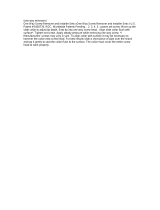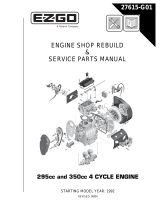Page is loading ...

G-DINK 300i
By KWANG YANG Motor Co., Ltd.
1st Edition, ,Mar. 2012
All rights reserved. Any reproduction or
unauthorized use without the written
permission of KWANG YANG Motor Co., Ltd.
is expressly prohibited.
T300-LHG7-A1

G-DINK 300i
PREFACE
This Service Manual describes the
technical features and servicing
procedures for the KYMCO
G-DINK 300i.
Section 1 contains the precautions for
all operations stated in this manual.
Read them carefully before any
operation is started.
Section 2 is the removal/installation
procedures for the frame covers
which are subject to
removal/installation frequency during
maintenance and servicing
operations.
Section 3 describes the inspection/
adjustment procedures, safety rules
and service information for each part,
starting from periodic maintenance.
Sections 5 to 12 give instructions for
disassembly, assembly and
adjustment of engine parts. Section
13 is the AFI system. Section 14 to 15
is the removal/ installation of chassis.
Section 16 to 19 states the testing
and measuring methods of electrical
equipment.
Most sections start with an assembly
or system illustration and
troubleshooting for the section. The
subsequent pages give detailed
procedures for the section.
KWANG YANG MOTOR CO., LTD.
QUALITY TECHNOLOGY DEPT.
EDUCATION SECTION
TABLE OF CONTENTS
GENERAL INFORMATION 1
EXHAUST MUFFLER/FRAME
COVERS
2
INSPECTION/ADJUSTMENT 3
LUBRICATION SYSTEM 4
ENGINE REMOVAL/INSTALLATION 5
CYLINDER HEAD/VALVES 6
CYLINDER/PISTON 7
DRIVE AND DRIVEN
PULLEYS/V-BELT
8
FINAL REDUCTION 9
A.C. GENERATOR/STARTER
CLUTCH
10
CRANKCASE/CRANKSHAFT 11
COOLING SYSTEM 12
FUEL INJECTION SYSTEM
13
STEERING HANDLEBAR/FRONT
WHEEL/FRONT BRAKE/FRONT
SHOCK ABSORBER/FRONT FORK
14
REAR BRAKE/REAR FORK/REAR
WHEEL/REAR SHOCK ABSORBER`
15
BATTERY/CHARGING SYSTEM 16
IGNITION SYSTEM 17
STARTING SYSTEM 18
LIGHTS SWITCHES / FUEL PUMP 19
The information and contents
included in this manual may be
different from the motorcycle in case
specifications are changed.
CHASSIS
ELE
C
TRI
C
AL
EQUIPMENT
ENGINE

1. GENERAL INFORMATION
1-0
G-DINK 300i
1
________________________________________________________________________________
________________________________________________________________________________
________________________________________________________________________________
________________________________________________________________________________
________________________________________________________________________________
GENERAL INFORMATION
________________________________________________________________________________
SERIAL NUMBER------------------------------------------------------------------------------------1-1
SPECIFICATION -------------------------------------------------------------------------------------1-2
SERVICE PRECAUTIONS-------------------------------------------------------------------------1-5
TORQUE VALUES-----------------------------------------------------------------------------------1-9
SPECIAL TOOLS----------------------------------------------------------------------------------- 1-11
LUBRICATION POINTS -------------------------------------------------------------------------- 1-12
CABLE & HARNESS ROUTING------------------------------------------------------------------- 1-14
TROUBLESHOOTING ---------------------------------------------------------------------------- 1-15
1

1. GENERAL INFORMATION
1-1
G-DINK 300i
Identification Numbers Record

1. GENERAL INFORMATION
1-2
G-DINK 300i
SPECIFICATIONS
Name G-DINK 300i
Model No. SH60AA
Overall length 2090 mm
Overall width 770 mm
Overall height 1360 mm
Wheel base 1450 mm
Engine type 4 stroke O.H.C.
Displacement 270.6 cc
Fuel Used
92# nonleaded
gasoline above
Front wheel
61
Rear wheel
99
Curb weight
(kg)
Total
160
Front wheel
105
Rear wheel
228
Max. weight
capacity (kg)
Total
333
Ground clearance (mm)
140
Braking distance (m)
7.9m / 40 km/hr
Min. turning radius (mm)
2350
Engine part
Starting system
Starting motor
Type
Gasoline 4-cycle
Cylinder arrangement Single cylinder
Combustion chamber type Semi-sphere
Valve arrangement O.H.C.-4V
Bore x stroke (mm) φ72.7 * 65.2
Compression ratio 10.6:1
Compression pressure
(kg/cm²)
15
Max. output (ps/rpm) 22.8 /8000
Max. torque (kg-m/rpm) 22.5 / 6500
Open 9° BTDC
Intake Timing
Close 36° BTDC
Open 42° BTDC
Exhaust
Timing
Close 7° BTDC
Intake
0.10
Valve
clearance
Exhaust
0.10
Idle speed (rpm) 1600±100 rpm
Cooling Type Liquid cooling
Lubrication type
Forced pressure &
wet sump
Oil pump type Inner/outer rotor
Oil filter type Full-flow filtration
Oil capacity 1.1 liter
Exchanging capacity 0.9 liter
Fi injection system
Air cleaner type & No Paper element, wet
Fuel capacity 9 liters
Brand Keihin
Throttle Body
Butterfly type
Venturi diameter (mm)
32
Fuel pump pressure
3 bar
Electrical system
Ignition type
ECU
Ignition timing
9°BTDC / idle
36° / 6500min
Spark plug DPR6EA
Spark plug gap 0.9mm
Battery Capacity 12V10AH
Transmission system
Clutch type Dry multi-disc
Transmission type
CVT
Operation type Auto centrifugal
Reduction gear type Two-stage reduction
1
st
0.72 ~ 2.24
Reduction ratio
2nd 7.222
Moving device
Tire type Tubeless
Front wheel
120/70-13
Tire spec.
Rear wheel 140/70-12
Front wheel 1.75
Tire pressure
(kg/cm²)
Rear wheel
2.0
Wheel material Aluminium
Left 40°
Turning angle
Right 40°
Front Disk brake
Brake type
Rear Disk brake
Damping Device
Front
Telescope
Suspension
type
Rear Swing arm
Front 95 mm Shock absorber
stroke
Rear 90 mm

1. GENERAL INFORMATION
1-3
G-DINK 300i
SERVICE PRECAUTIONS
Make sure to install new gaskets, O-rings,
circlips, cotter pins, etc. when
reassembling.
When tightening bolts or nuts, begin with
larger-diameter to smaller ones at several
times, and tighten to the specified torque
diagonally.
Use genuine parts and lubricants.
When servicing the motorcycle, be sure to
use special tools for removal and
installation.
After disassembly, clean removed parts.
Lubricate sliding surfaces with engine oil
before reassembly.
Apply or add designated greases and
lubricants to the specified lubrication
points.
When two persons work together, pay
attention to the mutual working safety.
Disconnect the battery negative (-) terminal
before operation.
When using a spanner or other tools,
make sure not to damage the motorcycle
surface.
After operation, check all connecting points,
fasteners, and lines for proper connection
and installation.
When connecting the battery, the positive
(+) terminal must be connected first.
After connection, apply grease to the
battery terminals.
Terminal caps shall be installed securely.
If the fuse is burned out, find the cause
and repair it. Replace it with a new one
according to the specified capacity.

1. GENERAL INFORMATION
1-4
G-DINK 300i
After operation, terminal caps shall be
installed securely.
When taking out the connector, the lock on
the connector shall be released before
operation.
Hold the connector body when connecting
or disconnecting it.
Do not pull the connector wire.
Check if any connector terminal is bending,
protruding or loose.
The connector shall be inserted
completely.
If the double connector has a lock, lock
it at the correct position.
Check if there is any loose wire.
Before connecting a terminal, check for
damaged terminal cover or loose negative
terminal.
Check the double connector cover for
proper coverage and installation.
Insert the terminal completely.
Check the terminal cover for proper
coverage.
Do not make the terminal cover opening
face up.
Secure wire harnesses to the frame with
their respective wire bands at the
designated locations.
Tighten the bands so that only the
insulated surfaces contact the wire
harnesses.
After clamping, check each wire to make
sure it is secure.
Confirm
Capacity

1. GENERAL INFORMATION
1-5
G-DINK 300i
Do not squeeze wires against the weld or
its clamp.
After clamping, check each harness to
make sure that it is not interfering with any
moving or sliding parts.
When fixing the wire harnesses, do not
make it contact the parts that will generate
high heat.
Route wire harnesses to avoid sharp
edges or corners. Avoid the projected
ends of bolts and screws.
Route wire harnesses passing through the
side of bolts and screws. Avoid the
projected ends of bolts and screws.
Route harnesses so they are neither
pulled tight nor have excessive slack.
Protect wires and harnesses with electrical
tape or tube if they contact a sharp edge or
corner.
When rubber protector cover is used to
protect the wire harnesses, it shall be
installed securely.
Do not break the sheath of wire.
If a wire or harness is with a broken sheath,
repair by wrapping it with protective tape or
replace it.
When installing other parts, do not press or
squeeze the wires.
After routing, check that the wire
harnesses are not twisted or kinked.
Do not pull
too tight!
No Contact
Do not press or
squeeze the wire

1. GENERAL INFORMATION
1-6
G-DINK 300i
Wire harnesses routed along with
handlebar should not be pulled tight, have
excessive slack or interfere with adjacent
or surrounding parts in all steering
positions.
When a testing device is used, make sure
to understand the operating methods
thoroughly and operate according to the
operating instructions.
Be careful not to drop any parts.
When rust is found on a terminal, remove
the rust with sand paper or equivalent
before connecting.
Do you understand
the instrument?
Remove Rust!

1. GENERAL INFORMATION
1-7
G-DINK 300i
Symbols:
The following symbols represent the
servicing methods and cautions included in
this service manual.
: Apply engine oil to the
specified points. (Use
designated engine oil for
lubrication.)
: Apply grease for lubrication.
: Transmission Gear Oil (90#)
: Use special tool.
: Caution
: Warning
Special
Engine Oil
Grease
Gear Oil
*

1. GENERAL INFORMATION
1-8
G-DINK 300i
TORQUE VALUES

1. GENERAL INFORMATION
1-9
G-DINK 300i
TORQUE VALUES

1. GENERAL INFORMATION
1-10
G-DINK 300i
TORQUE VALUES
FRAME

1. GENERAL INFORMATION
1-11
G-DINK 300i
SPECIAL TOOLS
Tool Name Tool No. Remarks Ref. Page
Flywheel puller E003 A.C. generator flywheel removal 4.10
One way clutch puller
Tappet adjuster
Oil seal & bearing installer
Flywheel holder
Clutch spring compressor
Thread protector
Bearing puller 10,12,15,18mm
E006
E012
E014
E021
E027
E029
E037
One way clutch removal
Tapper adjustment
Oil seal & bearing install
A.C. generator flywheel holding
Clutch disassembly
Protect the crankshaft’s thread
Bearing removal
9
3.7
9.10.11
4.10
9
10
10
Valve cotter installer E051 Valve cotter installation
7
Lock nut socket wrench F002 Steering stem removal or install
12

1. GENERAL INFORMATION
1-12
G-DINK 300i
LUBRICATION POINTS
FRAME
The following is the lubrication points for the frame.
Use grease for parts not listed.
Apply engine oil or grease to cables and movable parts not specified. It will avoid abnormal noise
and damage the durability of the motorcycle.
Grease
Grease
Front wheel axle &nut
Rea
r
wheel axle &nut
Grease
Side stand pivot
& Main stand pivot

1. GENERAL INFORMATION
1-13
G-DINK 300i
CABLE & HARNESS ROUTING
Tilt Switch
Speedometer
Radiator Filler Cap
Ignition Switch
ECU
Horn
Coolant Reserve Tank

1. GENERAL INFORMATION
1-14
G-DINK 300i
CABLE & HARNESS ROUTING
Fan Relay
Hi Beam Relay
Lo Beam Relay Fuel Pump Relay
ECU Relay Start Relay
Winker Relay

1. GENERAL INFORMATION
1-15
G-DINK 300i
ISC
Throttle Body
TPS
WTS
Injector MAP Sensor
O2 Sensor

1. GENERAL INFORMATION
1-16
G-DINK 300i
Starter Relay
Regulator/Rectifier
Crank Position Sensor
Ignition Coil
Hazard Control Unit
R l /R ifi

1. GENERAL INFORMATION
1-17
G-DINK 300i
TROUBLESHOOTING
ENGINE WILL NOT START OR IS HARD TO START
Possible cause
1. Check for operation of the fuel pump Abnormal ! Faulty fuel pump
Normal
2. Inspect the fuel flow Abnormal ! Faulty pressure regulator
Normal
3. Inspect the fuel injector Abnormal ! Faulty injector
Normal
4. Perform spark test Weak or no spark ! Faulty spark plug
! Fouled spark plug
! Faulty ECU
Good spark ! Broken or shorted spark plug wire
! Faulty ignition switch
! Faulty ignition pulse generator
! Loose or disconnected spark plug
wire
5. Test cylinder compression Low compression ! Valve stuck open
! Worn cylinder and piston ring
! Damaged cylinder head gasket
Compression normal ! Seized valve
! Improper valve timing
6. Starting following normal procedure Engine start ! Intake pipe leaking
but stops ! Improper ignition timing (Faulty
ignition coil or ignition pulse
generator)
Engine does not start ! Fuel contaminated
7. Remove and inspect spark plug Wet plug ! Throttle valve open
! Clogged air cleaner
/

